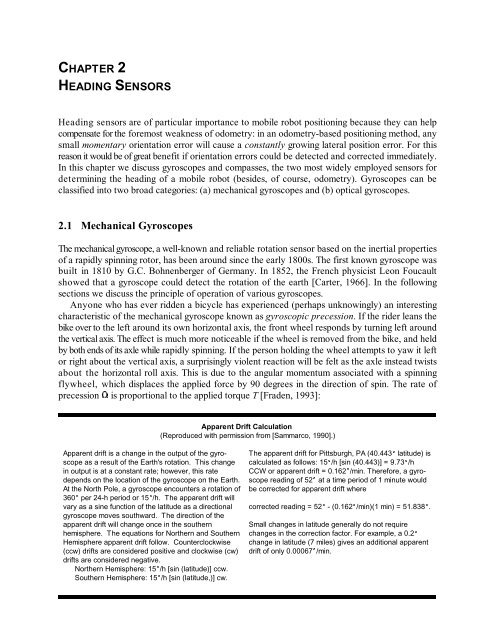Sensors and Methods for Mobile Robot Positioning
Sensors and Methods for Mobile Robot Positioning
Sensors and Methods for Mobile Robot Positioning
You also want an ePaper? Increase the reach of your titles
YUMPU automatically turns print PDFs into web optimized ePapers that Google loves.
CHAPTER 2<br />
HEADING SENSORS<br />
Heading sensors are of particular importance to mobile robot positioning because they can help<br />
compensate <strong>for</strong> the <strong>for</strong>emost weakness of odometry: in an odometry-based positioning method, any<br />
small momentary orientation error will cause a constantly growing lateral position error. For this<br />
reason it would be of great benefit if orientation errors could be detected <strong>and</strong> corrected immediately.<br />
In this chapter we discuss gyroscopes <strong>and</strong> compasses, the two most widely employed sensors <strong>for</strong><br />
determining the heading of a mobile robot (besides, of course, odometry). Gyroscopes can be<br />
classified into two broad categories: (a) mechanical gyroscopes <strong>and</strong> (b) optical gyroscopes.<br />
2.1 Mechanical Gyroscopes<br />
The mechanical gyroscope, a well-known <strong>and</strong> reliable rotation sensor based on the inertial properties<br />
of a rapidly spinning rotor, has been around since the early 1800s. The first known gyroscope was<br />
built in 1810 by G.C. Bohnenberger of Germany. In 1852, the French physicist Leon Foucault<br />
showed that a gyroscope could detect the rotation of the earth [Carter, 1966]. In the following<br />
sections we discuss the principle of operation of various gyroscopes.<br />
Anyone who has ever ridden a bicycle has experienced (perhaps unknowingly) an interesting<br />
characteristic of the mechanical gyroscope known as gyroscopic precession. If the rider leans the<br />
bike over to the left around its own horizontal axis, the front wheel responds by turning left around<br />
the vertical axis. The effect is much more noticeable if the wheel is removed from the bike, <strong>and</strong> held<br />
by both ends of its axle while rapidly spinning. If the person holding the wheel attempts to yaw it left<br />
or right about the vertical axis, a surprisingly violent reaction will be felt as the axle instead twists<br />
about the horizontal roll axis. This is due to the angular momentum associated with a spinning<br />
flywheel, which displaces the applied <strong>for</strong>ce by 90 degrees in the direction of spin. The rate of<br />
precession 6 is proportional to the applied torque T [Fraden, 1993]:<br />
Apparent Drift Calculation<br />
(Reproduced with permission from [Sammarco, 1990].)<br />
Apparent drift is a change in the output of the gyroscope<br />
as a result of the Earth's rotation. This change<br />
in output is at a constant rate; however, this rate<br />
depends on the location of the gyroscope on the Earth.<br />
At the North Pole, a gyroscope encounters a rotation of<br />
360( per 24-h period or 15(/h. The apparent drift will<br />
vary as a sine function of the latitude as a directional<br />
gyroscope moves southward. The direction of the<br />
apparent drift will change once in the southern<br />
hemisphere. The equations <strong>for</strong> Northern <strong>and</strong> Southern<br />
Hemisphere apparent drift follow. Counterclockwise<br />
(ccw) drifts are considered positive <strong>and</strong> clockwise (cw)<br />
drifts are considered negative.<br />
Northern Hemisphere: 15(/h [sin (latitude)] ccw.<br />
Southern Hemisphere: 15(/h [sin (latitude,)] cw.<br />
The apparent drift <strong>for</strong> Pittsburgh, PA (40.443( latitude) is<br />
calculated as follows: 15(/h [sin (40.443)] = 9.73(/h<br />
CCW or apparent drift = 0.162(/min. There<strong>for</strong>e, a gyroscope<br />
reading of 52( at a time period of 1 minute would<br />
be corrected <strong>for</strong> apparent drift where<br />
corrected reading = 52( - (0.162(/min)(1 min) = 51.838(.<br />
Small changes in latitude generally do not require<br />
changes in the correction factor. For example, a 0.2(<br />
change in latitude (7 miles) gives an additional apparent<br />
drift of only 0.00067(/min.

















